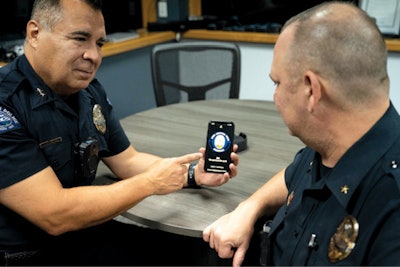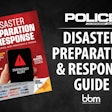 Chief Jeffrey Martinez of the Sheridan (CO) Police Department demonstrates one of the department’s apps. The department uses two new customized apps, one for crime and accident victim support and one to help officers in crisis.
Chief Jeffrey Martinez of the Sheridan (CO) Police Department demonstrates one of the department’s apps. The department uses two new customized apps, one for crime and accident victim support and one to help officers in crisis.
Chief Jeffrey A. Martinez remembers the day he was presented with technology that has now become critical to his agency’s support for both victims and officers in the small Denver suburb of Sheridan, CO.
“We were eating at Chili’s, me and a couple of my commanders here on the Sheridan Police Department, and this gentleman came up and started talking to us about victim assistance and how we were sharing information with victims,” Martinez says.
That bold “gentleman” was Barry Donovan, founder of Visible Digital Solutions LLC (VDS), a company that makes a digital business card. Donovan was working with the Colorado State Patrol on a new product called Electronic Victim Advocacy Cards (EVAC) that police could give to people who had been in accidents or were victims of crime. Martinez wanted to hear more, so he met with Donovan and agreed to adopt the technology for the Sheridan PD.
All of Sheridan’s 35 sworn officers now use EVAC. They carry paper cards that give accident and crime victims information on how to access the browser-based software. VDS customized the information on the browser for Sheridan PD, including a short video from the chief and all the resources victims need.
“You know a lot of times when citizens are a victim of a crime, their attention is not all there. We hand them paperwork, and later when they need it, they can’t find it. With EVAC, they have it on their phone,” Martinez says.
After seeing how well VDS’ software worked for victims, Martinez realized it could also be used to provide support for officers.
Martinez was named chief of the Sheridan PD in 2020 after a quarter-century with the Denver Police Department. In Denver, he had served with the peer support team. “Trying to help my fellow brother and sisters when they are in crisis is a top priority for me,” he says.
The Sheridan PD’s need for what became VDS’ Peer Support Card product was hammered home to Martinez during a conversation with one of the agency’s commanders. “I was told that one of our sergeants had come to this commander to tell him that one of our officers was having a ‘little bit of a crisis.’ I asked what was done about it.”
Martinez found the answer to that question alarming. No one knew what to do, so nothing was done, even though the agency works with a local practice for psychological services. Martinez was told no one knew how to contact them.
The Peer Support Card that VDS created for the Sheridan PD resolves that issue. Like the EVAC, the Peer Support Card is browser-based software that can be accessed by computer, tablet, or phone. The Sheridan PD’s peer support card includes contact information for peer support members and psychological services, and even information on how to relieve stress.
Martinez says sergeants are required to make sure that every officer has added the Peer Support Card to their agency-issued phones.
Sheridan PD’s Peer Support Card went live in December 2021. By June 2022, it had been loaded onto 76 mobile devices by officers and their loved ones. The software has since been accessed 355 times.

















